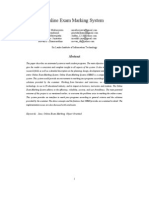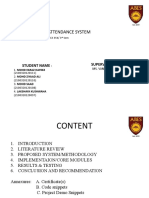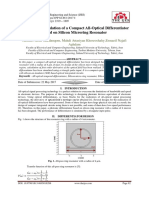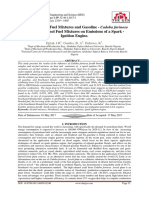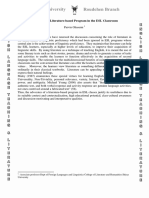An Automatic Attendance System Using Image Processing
Uploaded by
theijesAn Automatic Attendance System Using Image Processing
Uploaded by
theijesThe International Journal Of Engineering And Science (IJES)
|| Volume || 4 || Issue || 11 || Pages || PP -01-08|| 2015 ||
ISSN (e): 2319 1813 ISSN (p): 2319 1805
An Automatic Attendance System Using Image processing
1
Aziza Ahmedi , 2Dr Suvarna Nandyal
1
M. tech in ComputerScience and Engineering
PoojyaDodappaAppa College of Engineering, Kalaburagi, Karnataka, India.
2
HOD of Department of Computer Science and Engineering
PoojyaDodappaAppa College of Engineering, Kalaburagi, Karnataka, India.
------------------------------------------------------------ABSTRACT---------------------------------------------------------
The face is the identity of a person. The methods to exploit this physical feature have seen a
great change since the advent of image processing techniques. The attendance is taken in
every schools, colleges and library. Traditional approach for attendance is professor calls
student name & record attendance.The system described in this paper aims to deviate from
such traditional systems and introduce a new approach for taking an attendance using image
Processing.This paper describes the working of An Automatic Attendance System in a
classroom environment. Initially video clip of classroom is taken and is stored in the
database, and these video is converted to frames/images, then we apply Face detection
techniques such asAda-boost algorithm to detect the faces in frames/images and then features
are extracted of detected face by Histogram of Oriented Gradients (HOG) and Local Binary
Pattern (LBP) algorithm. The system first stores the faces of the students in the database. The
detected faces are compared with the faces stored in the database during face recognition by
using Support Vector Machine (SVM) classifier. If the system recognizes faces, the
attendance gets marked immediately of recognized faces.
Keywords- Face Recognition, Face Detection, AdaBoost, Local Binary pattern(LBP),
Histogram of Orientation(HOG), Support Vector machine(SVM).
----------------------------------------------------------------------------------------------------------------------------- ---------Date of Submission: 19 October 2015
Date of Accepted: 14 November 2015
----------------------------------------------------------------------------------------------------------------------------- ---------
I.
INTRODUCTION
A key factor of improving the quality of education is having students attend classes regularly. Traditionally
students are stimulated to attend classes using attendance points which at the end of a semester constitute a part
of a students final grade. However, traditionally this presents additional effort from the teacher, who must make
sure to correctly mark attending students, which at the same time wastes a considerable amount of time from the
teaching process. Furthermore it can get much more complicated if one has to deal with large groups of
students.
Maintaining the attendance is very important and compulsory in all the institutes for checking the performance
of students. Every institute has its own method in this regard. Some are taking attendance manually using the
old paper or file based approach and some have adopted methods of automatic attendanceusing some biometric
techniques. There are many automatic methods availableforthis purpose i.e. biometric attendance. All these
methods also waste time because students have to make a queue to touch their thumb on the scanning device.
Organizations of all sizes use attendance systems to record when student or employees start and stop work, and
the department where the work is performed. When it comes to schools and universities, the attendance
monitoring system is a great help for parents and teachers both. Parents are never uninformed of the
dependability of their children in the class if the university is using an attendance monitoring system. The
registers could easily be exploited by students and if information was mailed to the parents, there were high
chances that mails could be made to disappear before parents even saw them. With the monitoring system in
place, the information can easily be printed or a soft copy can be sent directly to parents in their personal email
accounts.
Hence, we proposed An Automatic Attendance system for students.
www.theijes.com
The IJES
Page 1
An Automatic Attendance System Using
II.PROPOSED METHODOLOGY
The system consists of a camera that captures the video of the students sitting in the classroom and sends it to
the administration server using the web service. For the database, the input are the image of the student, the preprocessing of the image is done and then the features of face are extracted using Local Binary Pattern (LBP)
and Histogram of Oriented Gradients(HOG), the features are eyes, nose, and mouth, and then it is subjected to
the Support Vector Machine (SVM) classifier. After all this process the images of the student are stored in the
database.
In the administration server, videois processed.From the video we generate number of frame/images. The the
pre-processing of the image/frame is doneand then image subjected to the Face Detection where faces from the
image/frame is detected. The features of the face are to be extracted in the feature extraction module using LBP
and HOG; the features are eyes, nose, and mouth.Then the SVM training is done on the faces. Here all the faces
are detected from the input image and the algorithm compares them one by one with the face database. If the
features of the face match that with the face of the database then the attendance is marked from where anyone
can access and use it for different purposes. Teachers come in the class and just press a button to start the
attendance process and the system automatically gets the attendance without even the intensions of students and
teacher. In this way a lot of time is saved and this is highly securing process no one can mark the attendance of
other. Camera takes the video continuously to detect andrecognize all the students in the classroom.
In order to avoid the false detection we are using the Ada boost technique. Using this technique enhance the
efficiency and accuracy of the detection process.
Pre-processing
Gray Conversion
Feature Extraction
(CSLBP & HOG)
Input Images
SVM Training
Resize
Knowledge Base
Frame Generation
Pre-processing
Face Detection
Using Adaboost
Pre-processing
Feature Extraction
(CSLBP & HOG)
Print the Results
into Exel doc
Head Count Using
Classification
Result
SVM Classification
Gray Conversion
Display Result
Fig. 1. System Architecture
III. ALGORITHM
This section describes the software algorithmfor the system. The algorithm consists of thefollowing steps
Creation of database
Video acquisition
Frame generation
Pre processing
Face detection
Face recognition
Attendance
www.theijes.com
The IJES
Page 2
An Automatic Attendance System Using
Start
Person 1
Face
images
Person 2
Face
images
Select Query
Video
Person n
Face
Images
Frame Generation
Pre-processing
Read the images
Faces
Face Detection using
ADABOOST
Pre-processing
Feature Extraction
Extract Features
from Images
SVM Classification
Train the features
using SVM
Retrieve Result Based
on Decision Value
Knowledge
Base
End
Fig. 2. Data Flow Diagram
3.1 Creation of Database
In this module we are going to maintain student details in the database which includeinformation like Branch,
SEM, Name, USN etc.and we also store the image of allstudents in the database for further process.
These images are preprocessed in this the RGB image is converted to binary image, then from the binary image
we extract the features, the features to be extracted are eyes, nose, and mouth using Histogram of Orientation
Gradients(HOG) and Linear Binary Pattern(LBP) algorithms. These features extracted are loaded into SVM for
training the features where SVMs are set of related supervised learning methods used for classification and
regression.They belong to a family of generalized linearclassification. A special property of SVM is,
SVMsimultaneously minimize the empiricalclassification error and maximize the geometricmargin. So SVM
called Maximum MarginClassifiers. Here we are creating a double matrix so our training data are no. of row
vectors and column vectors.
1) The SVM classification function F(x), F(x) = wxb. w is the weight vector and b is the bias.
2)ComputeLagranges Function LP
LP = L(w, b, )
= 1/2w.w -i{yi(wxib)1}
Where i is a Lagranges multiplier.
3) The kernel used is Radial Basis Function (RBF):
K (xi ,xj) = exp(- xi - xj2) , > 0
is kernel parameter.
4) Samples along the hyperplanes are called
Support Vectors (SVs).All the support vectors SVs are stored in the format as follows: [SVs from Class 1, SVs
from Class 2, ... SVs from Class L];
We use nonlinear kernel to solve classification problems, so we need the cost parameter (C) and kernel
parameters ().Then we will load the features extracted when applied HOG and LBP along with the above
algorithm result leads to SVM training and these is stored in the database.
3.2 FaceDetection and Feature Extraction of Face
Detecting a face is in essence an object detection task, where the object of interest in this case is the face.
However, many factors can interfere with the face detection algorithms, factors such as face pose, scale,
position, rotation, light, image colors etc. There are plenty face detection algorithms which can effectively
detect a face (or any other specific object) in a picture. In the system presented here, most students face the
camera frontally hence we chose to use the HAAR classifier for face detection.The integral image computes a
www.theijes.com
The IJES
Page 3
An Automatic Attendance System Using
value at each pixel for example (x,y) that is the sum of the pixel values above to the left of (x,y). This is quickly
computed in one pass through the image Haar classifier is nothing but scalar product between the image & some
haar like structures. Feature is selected through Ada- boost. Ada-Boost provides an effective learning algorithm
and strong bounds on generalization performance. The overall form of the detection process is that of a
degenerate decision tree, what we call a cascade. A positive result from the first classifier triggers the
evaluation of a second classifier which has also been adjusted to achieve very high detection rates. A positive
result from the second classifier triggers a third classifier, and so on. A negative outcome at any point leads to
the immediate rejection of the sub-window. The cascade training process involves two types of tradeoffs. In
most cases classifiers with more features will achieve higher detection rates and lower false positive rates. At
the same time classifiers with more features require more time to compute. In principle one can use following
stages. i) the number of classifier stages, ii) the number of features in each stage, and iii) the threshold of each
stage, are traded off in order to minimize the expected number of evaluated features.A target is selected for the
minimum reduction in false positives and the maximum decrease in detection. Stages are added until the overall
target for false positive and detection rate is met.After a face has been detected, it will display the result as face
detected with the faces of the student.
After theface detection next procedure is to extract the features of face which is called the feature extraction,
algorithms used are Local Binary Pattern (LBP) and Histogram of Oriented Gradients (HOG).
3.2.1 Histogram of Oriented Gradients
1) Gradient Computation
For the gradient computation first the gray scale image is filtered to obtain x and y derivatives of pixels using
conv2(image,filter,same) method with those kernels:
= [ -1 0 1]
=[
, for an image I, we obtain x
and y derivatives by using convolution operation:
then the magnitude and orientation of the gradient is also computed:
G
and = arctan
at orientation calculation rad2deg(atan2(val)) method is used, which returns values between [-180,180].
2) Orientation Binning
The next step is to compute cell histograms for later use at descriptor blocks. For 8x8 pixel size cells are
computed with 9orientation bins for [0,180] interval. For each pixels orientation, the corresponding
orientation bin is found and the orientations magnitude |G| is voted to this bin.
3) Descriptor Blocks
To normalize the cells orientation histograms, they should be grouped into blocks. From the two main block
geometries, the implementation uses R-HOG geometry. Each R-HOG block has 2x2 cells and adjacent R-HOGs
are overlapping each other for a magnitude of half-size of a block.
4) Block Normalization
L1-Norm normalization is implemented using norm(vec) method:
e is a small constant.
6) Detector Window
The detector window will be computed based on the size image.
3.2.2Local Binary Pattern
Given a pixel in the image, an LBP code is computed bycomparing it with its neighbors
s
wheregcis the gray value of the central pixel, gpis the value ofits neighbors, P is the total number of involved
neighbors and Ris the radius of the neighborhood.Suppose the coordinate of gcis (0, 0), then the coordinates of
gpare
(Rcos(2 p / P), Rsin(2 p / P)). After the LBP pattern of each pixel is identified, a histogram is built to represent
the texture
image:
www.theijes.com
The IJES
Page 4
An Automatic Attendance System Using
k [0 , K ]
whereK is the maximal LBP pattern value.Then it return the histogram of the center pixel calculated.
Finally, the system does recognize the face. After extracting the features from the given image, a recognizer is
needed to recognize the face image from the stored database. This phase involves a SVM classification
algorithm. The features extracted by HOG and LBP for the faces of student are loaded into the SVM classifier,
SVM Classifier here is mainly used to do the input parameter checking if the features of a face of particular
student matches with the features of face of student in the database then the decision value for that face will be 1
then attendance is marked automatically.
An error message is displayed if there are faces that does not with the faces of database. In this way faces of
students are verified one by one with the face database using the SVM classification and attendance is marked
on the server.
IV. IMPLEMENTATION
The proposed plan for An Automatic Attendance System using image processing includes:
Enrolment of student faces.
Capturing the video of students.
Face detection and feature extraction.
Face recognition and marking attendance.
Following are the screenshots of the implementation of this project.
4.1 Creation of Database
This window shows the creation of database of the students
Fig. 3.
The Database Creation of Students.
4.2 Menu Form
This window contains the list of menu items.
detection and exit.
The menus are create database, SVM training, select video, face
Fig. 4.The Menu Form
www.theijes.com
The IJES
Page 5
An Automatic Attendance System Using
4.3 Video Acquisition
Video is acquired from a high definition camera that is connected in the class room such that all the student
faces to the camera. This camera is connected to the computer. It captures video for 2 minutes and sends
thesevideo to the computer for processing.
Frames
Fig. 5. The sitting arrangement of student in classroom
4.4 Image Conversion
The input image which is in RGB format is first converted into the gray-scale image. For this process, we
calculate the average value of RGB for each pixel and if the average value is below than any specified value like
110, we replace it by black pixel and otherwise we replace it by white pixel. By this method, we get a binary
image from RGB image.
Histogram normalization is good technique for contrast enhancement in spatial domain
Fig. 6.
Histogram Equalized Image
4.5Frame Generation
After inputting the videoto the computer, frame generation is first performed by dynamic frame generation of
video. We get no. of frames/images, the generation of frames/images per/sec is 30 to 40 frames. The length of
the input video captured is 1 minute 8 sec, hence the generation of frame is huge, so we can select the frames in
between, like between 99 to 1356. Hence the frames will be processed between 99 to 1356 frames.
www.theijes.com
The IJES
Page 6
An Automatic Attendance System Using
Fig. 7. The Frame Generation
4.6 Face Detection
This window consists of the detecting faces.
These faces detected are from the video.
Fig. 8.Face Detection
4.7 Face Recognition
First the faces on the screen are traced out and the recognition process starts. During the recognition phase, the
detected facial features are compared to the features stored in our database. If the system recognizes the features,
the corresponding face is recognized and the name of the recognized student is displayed on the screen in
message box.
Fig. 9. The name of the student in message box displayed after face reorganization
www.theijes.com
The IJES
Page 7
An Automatic Attendance System Using
4.8 Report
This window shows the report of the marked attendance. Attendance is marked along with the date and the time
for each student for that particular lecture in excel document.
Fig. 10. Report
V.CONCLUSION
Our proposed project, An Automated Attendance System has been envisioned for the purpose of reducing the
errors that occur in the traditional (manual) attendance taking system. The aim is to automate and make a system
that is useful to the organization such as an institute. The camera plays a crucial role in the working of the
system hence the image quality and performance of the camera in real-time scenario must be tested thoroughly
before actual implementation.
This method is secure enough, reliable and available for use. No need for specialized hardware for installing the
system in the classroom. It can be constructed using a camera and computer.
REFERENCES
[1]
[2]
[3]
[4]
[5]
[6]
[7]
[8]
[9]
[10]
[11]
[12]
[13]
[14]
Tabassamnawaz, SaimPervaiz, ArashKorrani, Azhar-ud-din,Development of Academic Attendence Monitoring System Using
Fingerprint Identification, IJCSNS International Journal of Computer Science and Network Security, VOL.9No.5,May 2009.
Y. Li, S. Gong, and H. Liddell. Supportvector regression and classification basedMulti-view face detection and recognition.In
IEEE International Conference onAutomatic Face and Gesture Recognition,March 2000.
NirmalyaKar, MrinalKantiDebbarma, AshimSaha, and DwijenRudra Pal. Study of Implementing Automated Attendance
System Using Face Recognition Technique. International Journal of Computer and Communication Engineering, Vol. 1, No. 2,
July 2012.
Alexander Kuranov, Rainer Lienhart, andVadimPisarevsky. An Empirical Analysisof Boosting Algorithms for Rapid
ObjectsWith an Extended Set of Haar-like Features.Intel Technical Report MRL-TR-July02-01;2002
Phillip Ian Wilson, John Fernandez, Facial Feature Detection Using Haar Classifiers. Journal of Computing Sciences in
Colleges;2006.
ZhenhuaGuo, Lei Zhang, Member, IEEE, and David Zhang*, Fellow, IEEE.A Completed Modeling of Local Binary Pattern
Operator for Texture Classification. Submitted to IEEE Transactions on Image Processing.
Durgesh k. Srivastava, Lekhabhambhu Data classification using support vectorMachine Journal of Theoretical and Applied
Information Technology.
Martin Hofmann Support Vector Machines Kernels and the Kernel Trick June 26, 2006.
David Cristinacce and Tim Cootes Facial feature detection using AdaBoost with shape constraints.
M. Mattam, S. R. M. Karumuri, and S. R. Meda, Architecture for Automated Student Attendance, in Proc. IEEE Fourth
International Conference on Technology for Education (T4E 2012), pp.164-167, 18-20 July 2012, doi: 10.1109/T4E.2012.39
Phillip Ian Wilson, and Dr. John Fernandez, FACIAL FEATURE DETECTION USING HAAR CLASSIFIERS, Texas A&M
University
J. G. RoshanTharanga,S. M. S. C. Samarakoon, T. A. P. Karunarathne SMART ATTENDANCE USING REAL TIME FACE
RECOGNITION (SMART - FR) Department of Electronic and Computer Engineering
W. Zhao, R. Chellappa, P. J. Phillips, and A. Rosenfeld, Face recognition: A literature survey, ACM Computing Surveys,
2003, vol. 35, no. 4, pp. 399-458.
Abhishekjha Class Room Attendance System Using Facial Recognition System The International Journal of
Mathematics, Science, Technology and Management(ISSN : 2319-8125) Vol. 2 Issue 3
www.theijes.com
The IJES
Page 8
You might also like
- Research Paper - Online Exam Marking SystemNo ratings yetResearch Paper - Online Exam Marking System5 pages
- Automatic Attendance Using Face RecognitionNo ratings yetAutomatic Attendance Using Face Recognition4 pages
- Design and Implementation of An Online Student Clearance System (Case Study Delta State Polytechnic, Ozoro)No ratings yetDesign and Implementation of An Online Student Clearance System (Case Study Delta State Polytechnic, Ozoro)57 pages
- Project Synopsis: Name: Bhavya Baheti Class: Sy B.SC CS A Roll No.: 302No ratings yetProject Synopsis: Name: Bhavya Baheti Class: Sy B.SC CS A Roll No.: 3024 pages
- Face Detection Attendance System SynopsisNo ratings yetFace Detection Attendance System Synopsis5 pages
- Design and Implementation of Integrated Mobile Responsive Student Enrolment SystemNo ratings yetDesign and Implementation of Integrated Mobile Responsive Student Enrolment System9 pages
- BCA VB Project On Examination Management System - PDF Report With Source CodeNo ratings yetBCA VB Project On Examination Management System - PDF Report With Source Code111 pages
- Online College Admission Management System Project100% (1)Online College Admission Management System Project6 pages
- Student Union Voting System For Wolkite University Final0% (2)Student Union Voting System For Wolkite University Final10 pages
- CHAPTER-1-2-Voting-Management-System Using Facial RecognitionNo ratings yetCHAPTER-1-2-Voting-Management-System Using Facial Recognition23 pages
- Internal Mark Assessment System: Purpose of The ProjectNo ratings yetInternal Mark Assessment System: Purpose of The Project3 pages
- Exam Management System FOR School of Engineering Cusat: Mini Project Report OnNo ratings yetExam Management System FOR School of Engineering Cusat: Mini Project Report On43 pages
- Accomation of Inter College Event (Repaired)No ratings yetAccomation of Inter College Event (Repaired)71 pages
- The Development of Electronic Health Record For Aldersgate College School Clinic Using SCRUM Framework of Agile MethodologyNo ratings yetThe Development of Electronic Health Record For Aldersgate College School Clinic Using SCRUM Framework of Agile Methodology78 pages
- The Problem and Review of Related LiteratureNo ratings yetThe Problem and Review of Related Literature10 pages
- Automated Faculty Evaluation System Using PHP and mySQL100% (1)Automated Faculty Evaluation System Using PHP and mySQL7 pages
- Improving The Efficiency of The Computation of Grades Using Computerized Grading System100% (1)Improving The Efficiency of The Computation of Grades Using Computerized Grading System8 pages
- Web Based Student Information Management System100% (1)Web Based Student Information Management System7 pages
- University Mangament System Using Artificial IntelligenceNo ratings yetUniversity Mangament System Using Artificial Intelligence14 pages
- An Online Voting System Using Biometric Fingerprint and Aadhaar CardNo ratings yetAn Online Voting System Using Biometric Fingerprint and Aadhaar Card6 pages
- Design and Implementation of Online Clearance System - ProjectclueNo ratings yetDesign and Implementation of Online Clearance System - Projectclue1 page
- Automated Class Attendance Management System Using Face RecognitionNo ratings yetAutomated Class Attendance Management System Using Face Recognition7 pages
- Title Automated Student Attendance Management System Using Face Recognition Domain: Image Processing, Deep Learning ObjectiveNo ratings yetTitle Automated Student Attendance Management System Using Face Recognition Domain: Image Processing, Deep Learning Objective8 pages
- Defluoridation of Ground Water Using Corn Cobs PowderNo ratings yetDefluoridation of Ground Water Using Corn Cobs Powder4 pages
- Development of The Water Potential in River Estuary (Loloan) Based On Society For The Water Conservation in Saba Coastal Village, Gianyar RegencyNo ratings yetDevelopment of The Water Potential in River Estuary (Loloan) Based On Society For The Water Conservation in Saba Coastal Village, Gianyar Regency9 pages
- Design and Simulation of A Compact All-Optical Differentiator Based On Silicon Microring ResonatorNo ratings yetDesign and Simulation of A Compact All-Optical Differentiator Based On Silicon Microring Resonator5 pages
- Influence of Air-Fuel Mixtures and Gasoline - Cadoba Farinosa Forskk Bioethanol Fuel Mixtures On Emissions of A Spark - Ignition Engine.No ratings yetInfluence of Air-Fuel Mixtures and Gasoline - Cadoba Farinosa Forskk Bioethanol Fuel Mixtures On Emissions of A Spark - Ignition Engine.9 pages
- Pseudology - Derrida On Arendt and Lying in PoliticsNo ratings yetPseudology - Derrida On Arendt and Lying in Politics9 pages
- The Role of Literature in English Language Teaching100% (1)The Role of Literature in English Language Teaching7 pages
- Group #2, Professionals & Practitioners of Counseling67% (12)Group #2, Professionals & Practitioners of Counseling31 pages
- OVPAA Memo 2021-19A-Corrected - Additional Guidelines For He Remainder of AY 2020-2021No ratings yetOVPAA Memo 2021-19A-Corrected - Additional Guidelines For He Remainder of AY 2020-20212 pages
- Nonparametric Testing Using The Chi-Square Distribution: Reading TipsNo ratings yetNonparametric Testing Using The Chi-Square Distribution: Reading Tips4 pages
- Mpu3113 Hubungan Etnik Assignment-Sept20No ratings yetMpu3113 Hubungan Etnik Assignment-Sept205 pages
- (Ebook) The slow professor: challenging the culture of speed in the academy by Berg, Maggie;Seeber, Barbara K ISBN 9781442645561, 9781442663107, 9781487521851, 1442645563, 1442663103, 1487521855 2024 scribd download100% (8)(Ebook) The slow professor: challenging the culture of speed in the academy by Berg, Maggie;Seeber, Barbara K ISBN 9781442645561, 9781442663107, 9781487521851, 1442645563, 1442663103, 1487521855 2024 scribd download65 pages
- The Integration of Multimodality in English Teaching in Indonesian Junior High SchoolsNo ratings yetThe Integration of Multimodality in English Teaching in Indonesian Junior High Schools314 pages
- Behavioral Event Interview: A. Teaching AbilityNo ratings yetBehavioral Event Interview: A. Teaching Ability16 pages
- Design and Implementation of An Online Student Clearance System (Case Study Delta State Polytechnic, Ozoro)Design and Implementation of An Online Student Clearance System (Case Study Delta State Polytechnic, Ozoro)
- Project Synopsis: Name: Bhavya Baheti Class: Sy B.SC CS A Roll No.: 302Project Synopsis: Name: Bhavya Baheti Class: Sy B.SC CS A Roll No.: 302
- Design and Implementation of Integrated Mobile Responsive Student Enrolment SystemDesign and Implementation of Integrated Mobile Responsive Student Enrolment System
- BCA VB Project On Examination Management System - PDF Report With Source CodeBCA VB Project On Examination Management System - PDF Report With Source Code
- Online College Admission Management System ProjectOnline College Admission Management System Project
- Student Union Voting System For Wolkite University FinalStudent Union Voting System For Wolkite University Final
- CHAPTER-1-2-Voting-Management-System Using Facial RecognitionCHAPTER-1-2-Voting-Management-System Using Facial Recognition
- Internal Mark Assessment System: Purpose of The ProjectInternal Mark Assessment System: Purpose of The Project
- Exam Management System FOR School of Engineering Cusat: Mini Project Report OnExam Management System FOR School of Engineering Cusat: Mini Project Report On
- The Development of Electronic Health Record For Aldersgate College School Clinic Using SCRUM Framework of Agile MethodologyThe Development of Electronic Health Record For Aldersgate College School Clinic Using SCRUM Framework of Agile Methodology
- Automated Faculty Evaluation System Using PHP and mySQLAutomated Faculty Evaluation System Using PHP and mySQL
- Improving The Efficiency of The Computation of Grades Using Computerized Grading SystemImproving The Efficiency of The Computation of Grades Using Computerized Grading System
- University Mangament System Using Artificial IntelligenceUniversity Mangament System Using Artificial Intelligence
- An Online Voting System Using Biometric Fingerprint and Aadhaar CardAn Online Voting System Using Biometric Fingerprint and Aadhaar Card
- Design and Implementation of Online Clearance System - ProjectclueDesign and Implementation of Online Clearance System - Projectclue
- Automated Class Attendance Management System Using Face RecognitionAutomated Class Attendance Management System Using Face Recognition
- Title Automated Student Attendance Management System Using Face Recognition Domain: Image Processing, Deep Learning ObjectiveTitle Automated Student Attendance Management System Using Face Recognition Domain: Image Processing, Deep Learning Objective
- Defluoridation of Ground Water Using Corn Cobs PowderDefluoridation of Ground Water Using Corn Cobs Powder
- Development of The Water Potential in River Estuary (Loloan) Based On Society For The Water Conservation in Saba Coastal Village, Gianyar RegencyDevelopment of The Water Potential in River Estuary (Loloan) Based On Society For The Water Conservation in Saba Coastal Village, Gianyar Regency
- Design and Simulation of A Compact All-Optical Differentiator Based On Silicon Microring ResonatorDesign and Simulation of A Compact All-Optical Differentiator Based On Silicon Microring Resonator
- Influence of Air-Fuel Mixtures and Gasoline - Cadoba Farinosa Forskk Bioethanol Fuel Mixtures On Emissions of A Spark - Ignition Engine.Influence of Air-Fuel Mixtures and Gasoline - Cadoba Farinosa Forskk Bioethanol Fuel Mixtures On Emissions of A Spark - Ignition Engine.
- Pseudology - Derrida On Arendt and Lying in PoliticsPseudology - Derrida On Arendt and Lying in Politics
- The Role of Literature in English Language TeachingThe Role of Literature in English Language Teaching
- Group #2, Professionals & Practitioners of CounselingGroup #2, Professionals & Practitioners of Counseling
- OVPAA Memo 2021-19A-Corrected - Additional Guidelines For He Remainder of AY 2020-2021OVPAA Memo 2021-19A-Corrected - Additional Guidelines For He Remainder of AY 2020-2021
- Nonparametric Testing Using The Chi-Square Distribution: Reading TipsNonparametric Testing Using The Chi-Square Distribution: Reading Tips
- (Ebook) The slow professor: challenging the culture of speed in the academy by Berg, Maggie;Seeber, Barbara K ISBN 9781442645561, 9781442663107, 9781487521851, 1442645563, 1442663103, 1487521855 2024 scribd download(Ebook) The slow professor: challenging the culture of speed in the academy by Berg, Maggie;Seeber, Barbara K ISBN 9781442645561, 9781442663107, 9781487521851, 1442645563, 1442663103, 1487521855 2024 scribd download
- The Integration of Multimodality in English Teaching in Indonesian Junior High SchoolsThe Integration of Multimodality in English Teaching in Indonesian Junior High Schools

